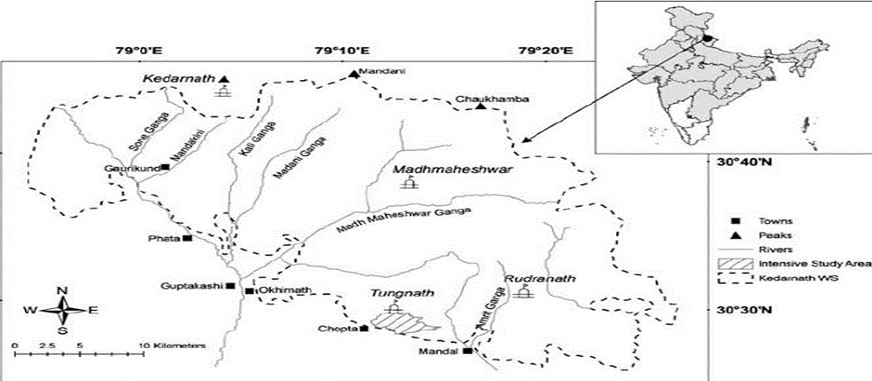KEDARNATH WILDLIFE SANCTUARY
Why in the News ?
- Chopper company in Uttarakhand is facing legal action under the Wildlife Protection (Amendment) Act 2022 for landing a helicopter in a restricted area of the Kedarnath Wildlife Sanctuary, with a Bollywood star on board.
Source: ResearchGate
Sanctuary’s Importance
The Madmaheshwar temple inside the sanctuary is a significant religious and ecological site, being one of the Panch Kedar temples located in the Garhwal Himalayas. It is situated at an altitude of 11,400 feet and is accessible through a 16 km trek.
Environmental Concerns
- The sanctuary is home to various wildlife, including species like musk deer listed on the IUCN Red List of Threatened Species. Excessive chopper movement in the area has drawn criticism for disturbing the sanctuary’s fragile ecosystem.
- The National Green Tribunal had previously expressed concern about the disturbance caused to animals in the sanctuary due to the excessive movement of helicopters in this ecologically vulnerable zone.
Kedarnath Wildlife Sanctuary
- The Kedarnath Wildlife Sanctuary is situated in the Garhwal region of Uttarakhand, India.
- It is also known as Kedarnath Musk Deer Sanctuary as its primary purpose is protecting the endangered Himalayan musk deer.
- The area near Kedarnath has been regarded as holy because of the Kedarnath Temple, recognized as one of the twelve Jyotirlingas (sacred dwellings of Lord Shiva) in Hindu mythology.
- Biodiversity : Shelters notable species like the Himalayan black bear, snow leopard, musk deer, Himalayan tahr, langur, serow, bharal (blue sheep), Himalayan monal, pheasants, and vultures.
- Geographical features : The sanctuary features towering mountains, snowy peaks, alpine grasslands, thick woods, and icy rivers.
- Mandakini River Flows through Kedarnath Wildlife Sanctuary.
- Flora:
- Lower Region : Coniferous Forest
- Middle Altitudes : Oak Forest
- Higher Altitude : Alpine Forest
- Others : Rhododendron forests and Medicinal Plants.




